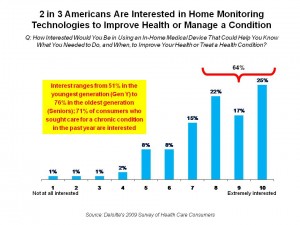 Three major consumer and health industry brand names are coming together to launch a telehealth home monitoring project: GE, Intel and the Mayo Clinic. Each organization has a deep bench and history in the health vertical, covering different segments of the market.
Three major consumer and health industry brand names are coming together to launch a telehealth home monitoring project: GE, Intel and the Mayo Clinic. Each organization has a deep bench and history in the health vertical, covering different segments of the market.
With this project, 3 industry leaders partner to learn about home health monitoring’s challenges and opportunities in real-life, with real people. The project goal is to evaluate the effectiveness of daily in-home monitoring technology measured in 2 ways: reduced hospital admissions and reduced visits to the emergency room.
For the project, Intel brings its Health Guide into the mix; GE offers a comprehensive portfolio of medical, digital, and bio/clinical products; and, Mayo brings its clinical expertise and, most importantly, patients who are managing chronic diseases. These will be 200 high-risk Mayo Clinic patients served by the Rochester, MN, provider. These patients will monitor vital signs on a daily basis through the Health Guide technology. The platform allows for videoconferencing between the patient at home and the care team back at Mayo to permit patient-provider connectivity.
Health Populi’s Hot Points: This project will test Participatory Health in a high-risk population. It will provide important insights into patient engagement in a population that’s been largely written off by other disease management programs in the past based on ageism, lack of good design of technology, and absence of a consumer-centric ethos.
Mayo has long been a patient-centric, wired organization. Their commitment to continuing to lead and innovate builds their brand as one of consumers (and I speak globally) most favored health brands. Intel has been studying how people manage activities of daily living, including health functions, for a long time, making a strategic investment in the future of home health, broadly writ. And GE Healthcare, for all of its moving parts in health, certainly has the clinical and digital building blocks for the infrastructure of home health monitoring.
The three partners are the bluest-chip in the industry, so those pieces of the home health innovation puzzle fit nicely into this challenge. The largest challenge facing the team is patient engagement: how will the 200 high-risk chronically ill, over 60-year-old people fare in this project? The chart illustrates that 2 in 3 American adults like the idea of home monitoring technologies at home to help “me” manage my health. Interestingly, seniors polled were the most interested in these technologies, bringing those who like home monitoring tech to 3/4 of the population.
So, generally speaking for seniors, most will probably like the idea of this project. The next hurdle is how to design the front-end technology (Health Guide and vital signs devices) such that people will find them easy, and perhaps even fun and engaging, to use. Here’s where we’d like to see Apple, IDEO, or other design-minded firm involved.




 Interviewed live on BNN Bloomberg (Canada) on the market for GLP-1 drugs for weight loss and their impact on both the health care system and consumer goods and services -- notably, food, nutrition, retail health, gyms, and other sectors.
Interviewed live on BNN Bloomberg (Canada) on the market for GLP-1 drugs for weight loss and their impact on both the health care system and consumer goods and services -- notably, food, nutrition, retail health, gyms, and other sectors. Thank you, Feedspot, for
Thank you, Feedspot, for  As you may know, I have been splitting work- and living-time between the U.S. and the E.U., most recently living in and working from Brussels. In the month of September 2024, I'll be splitting time between London and other parts of the U.K., and Italy where I'll be working with clients on consumer health, self-care and home care focused on food-as-medicine, digital health, business and scenario planning for the future...
As you may know, I have been splitting work- and living-time between the U.S. and the E.U., most recently living in and working from Brussels. In the month of September 2024, I'll be splitting time between London and other parts of the U.K., and Italy where I'll be working with clients on consumer health, self-care and home care focused on food-as-medicine, digital health, business and scenario planning for the future...